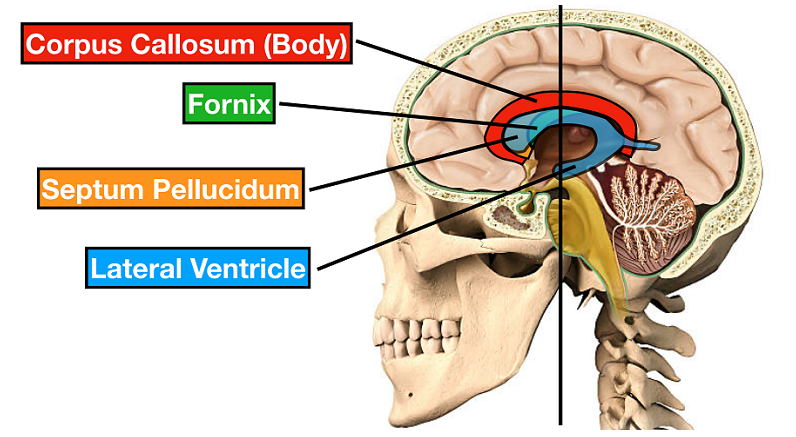
In the intricate labyrinth of the human brain lies a structure shrouded in mystery – the septum pellucidum. Nestled deep within, this slender, nearly transparent partition plays a silent yet significant role in our cognitive and emotional lives. Often overlooked in discussions of brain anatomy, the septum pellucidum is a fascinating subject deserving closer examination. Here we explore its structure, functions, and the crucial role it plays in neurological health.
Contents
Anatomy of the Septum Pellucidum
The septum pellucidum is a delicate structure within the brain, often unnoticed due to its size and location. To fully appreciate its role and significance, it’s essential to understand its anatomical features.
Location of the Septum Pellucidum in the Brain
The septum pellucidum is situated in the midline of the brain, nestled between the left and right lateral ventricles. It lies just below the corpus callosum, a large bundle of nerve fibers that connects the two hemispheres of the brain. This positioning allows the septum pellucidum to serve as a partition between the two ventricles, contributing to the regulation of cerebrospinal fluid flow within these cavities.
Structural Description of the Septum Pellucidum
Structurally, the septum pellucidum is a thin, double-layered membrane made up of glial cells and nerve fibers. It is typically about 2 to 4 mm thick, varying slightly among individuals. The two layers of the septum pellucidum are the laminae, which are joined together at their medial borders but separate laterally to form the septal cavities or clefts. These cavities are often asymmetrical and can vary greatly in size, sometimes even absent in some individuals.
Connection of the Septum Pellucidum to Other Brain Parts
The septum pellucidum is intricately connected to various parts of the brain, playing a role in both its physical structure and functional dynamics. It is closely associated with the limbic system, particularly the hippocampus and amygdala, which are key areas for memory and emotional processing.
Additionally, it interacts with the thalamus and hypothalamus, influencing various autonomic and endocrine functions. These connections underscore the importance of the septum pellucidum in the overall neural network and its impact on cognitive and emotional health [1].

Functions of the Septum Pellucidum
While the septum pellucidum may be small and unassuming in its physical presence, its functions within the brain are both diverse and significant.
Septum Pellucidum Cognitive Processes
One of the key functions of the septum pellucidum is its involvement in cognitive processes. It plays a role in memory formation and retrieval, largely due to its connections with the hippocampus. This relationship is critical in the consolidation of new memories and the stability of long-term memories. Furthermore, the septum pellucidum is implicated in spatial navigation and orientation, helping to process and integrate sensory information to form a coherent spatial understanding of our surroundings.
Septum Pellucidum and Emotional Regulation
The septum pellucidum also has a significant role in emotional regulation. Its connections with the amygdala, a region of the brain integral to emotional processing, suggest that the septum pellucidum is involved in controlling emotional responses. It is thought to contribute to the modulation of fear and pleasure responses, influencing how individuals perceive and react to various emotional stimuli. This function is crucial in maintaining emotional balance and can have implications in mental health disorders where emotional regulation is disrupted [2].
Role of the Septum Pellucidum in Neurological Health
Beyond cognitive and emotional aspects, the septum pellucidum contributes to overall neurological health. It is involved in the regulation of autonomic functions by its interactions with the hypothalamus. This includes roles in appetite control, sleep regulation, and the stress response.
Additionally, the health and integrity of the septum pellucidum are important in maintaining the structural integrity of the brain’s ventricular system, ensuring proper circulation of cerebrospinal fluid. This not only protects brain tissue but also aids in the removal of waste products, which is essential for optimal brain function.
Disorders Associated with the Septum Pellucidum
The septum pellucidum, despite its small size, can be linked to a range of neurological disorders. Its involvement in these conditions highlights the importance of understanding its structure and functions in the broader context of brain health. This section explores some of the key disorders associated with abnormalities in the septum pellucidum.
Septo-Optic Dysplasia and the Septum Pellucidum
Septo-optic dysplasia (SOD) is one of the most direct disorders associated with the septum pellucidum. This rare congenital condition is characterized by the underdevelopment of the septum pellucidum and optic nerve. Individuals with SOD often have vision problems and hormonal deficiencies, as the disorder can also affect the pituitary gland [3].
The absence or malformation of the septum pellucidum in SOD can lead to a range of neurological symptoms, including developmental delays and learning difficulties, highlighting the septum’s role in cognitive functions.
The Septum Pellucidum and Schizophrenia and Bipolar Disorders
Research has also indicated a potential link between the septum pellucidum and certain psychiatric conditions, such as schizophrenia and bipolar disorder. Studies have found variations in the size and structure of the septum pellucidum in individuals with these disorders compared to the general population.
While the exact role of the septum pellucidum in these conditions is not fully understood, it is believed that its involvement in emotional regulation and cognitive processing may contribute to the symptoms observed in these disorders.
Impact of the Septum Pellucidum on Cognitive and Emotional Health
The health of the septum pellucidum can have broader implications for cognitive and emotional well-being. Disorders affecting this part of the brain can lead to a range of symptoms, from memory issues and spatial disorientation to emotional imbalances and behavioral changes.
Understanding the role of the septum pellucidum in these disorders is crucial for developing effective treatments and management strategies. It also underscores the need for further research to unravel the complexities of this small yet significant brain structure [4].

The Septum Pellucidum in Broader Neurological Research
The septum pellucidum, while a specific focus within neuroanatomy, also plays a pivotal role in broader neurological research.
Contributions of the Septum Pellucidum to Understanding Brain Function
The study of the septum pellucidum provides valuable insights into the intricate workings of the brain. By examining its connections and interactions with other brain regions, researchers can better understand the complex networks that govern cognitive and emotional processes.
The septum pellucidum’s role in memory formation, spatial navigation, and emotional regulation offers a window into how these fundamental functions are managed and integrated within the brain. This research is crucial not only for understanding normal brain function but also for unraveling the mechanisms behind various neurological disorders [5].
Comparative Studies of the Septum Pellucidum with Other Species
Comparative neuroanatomy has revealed interesting parallels and differences in the septum pellucidum across various species. By studying this structure in animals, researchers gain insights into its evolutionary development and functional significance. Such comparisons have shown variations in the septum pellucidum’s size, structure, and complexity, which can be correlated with different cognitive and behavioral capabilities in animals. These findings not only enhance our understanding of animal neurobiology but also provide a comparative framework for understanding human brain function and its evolutionary context.
Potential for Future Breakthroughs in Septum Pellucidum Research
The ongoing research into the septum pellucidum holds promise for future breakthroughs in neuroscience. With advancements in imaging technology and molecular biology, we are now better equipped to study this small brain structure in greater detail.
Understanding the septum pellucidum’s full range of functions and its involvement in neurological disorders could lead to new diagnostic tools and therapeutic approaches. Additionally, as our knowledge of this structure expands, it may reveal new aspects of brain function and pathology that were previously unknown, opening new avenues for research and treatment in neurology and psychiatry.
References
[1] Cavum Septum Pellucidum
[2] Septum pellucidum
[3] Absence of septum pellucidum
[4] Neural and vascular architecture of the septum pellucidum
[5] Imaging of the septum pellucidum: normal, variants and pathology

